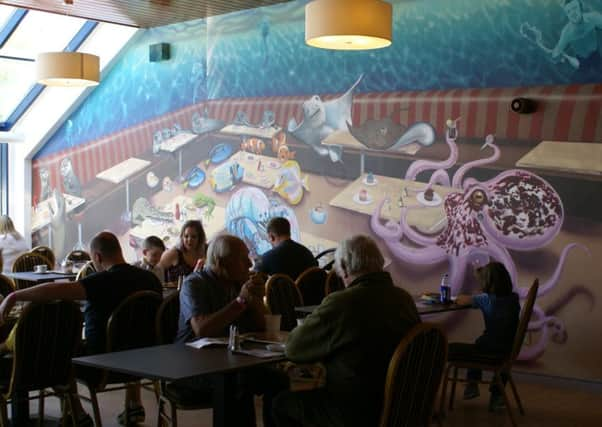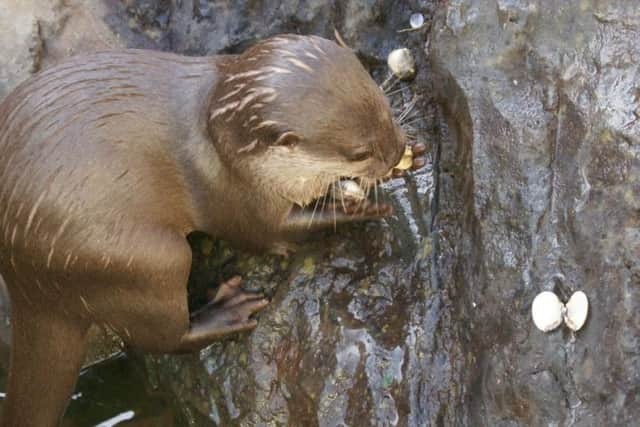Anemone anomalies, cheeky monkeys, and jet propelled fossils


Perhaps this anemone anomaly reminded him of his great grandfather’s beard on a faded old family photograph at home!
He asked his mother “are the ones without whiskers the children and will they get hairy when they’re older?”
Advertisement
Hide AdAdvertisement
Hide AdBecause of the delighted chatter of the crowds in Portaferry’s new-look, undersea wonderland, I didn’t hear his mother’s reply, but I remembered that Beatles drummer Ringo Starr faced another marine anomaly whilst cruising the fish-laden seas off Sardinia in 1969.


Ringo loved fish and chips and wasn’t at all pleased to discover that a traditional British cod supper wasn’t readily available in Sardinia!
Why not, he wondered.
Because today there are only squid on the menu, he was told.
So he ate his first squid and reckoned that it “tasted OK, but a bit rubbery.”


Advertisement
Hide AdAdvertisement
Hide AdWhen he was informed that local folk ate octopuses too, Ringo was inspired to write Octopus’s Garden, which he recorded with the Beatles for their Abbey Road album in 1969.
“I’d like to be, under the sea,
In an octopus’s garden in the shade.”
I reported about Exploris on BBC Radio Ulster when the aquarium was first opened in 1987, and used Ringo’s song as background music.
“Oh what joy for every girl and boy, in an octopus’s garden in the shade.”
Exploris has been in the shade since it closed in 2014, but when it reopened recently after a £2 million face-lift, Ringo’s words still echoed in my mind, still manifestly true.
Advertisement
Hide AdAdvertisement
Hide AdExcept that joy was shared, not just by girls and boys, but by babies in prams, adults, pensioners, and unless I was mistaken, by more than a few of Exploris’s well-contented undersea inhabitants!
The answer to the little boy’s question about sea anemones’ whiskers was doubtlessly on the information screen above their tank, but many more colourful marine creatures, each with a screen, awaited his attention, and he dragged his mother off to the next under-sea exhibit!
The screens are almost as absorbing as the sea creatures, offering some remarkable detail - lobster’s teeth are in its stomach; three-spined sticklebacks don’t have scales, but are armour-plated; the jet-propelled ‘living fossil’ Chambered Nautilus hasn’t changed for over 400 million years, and the deadly-poisonous Stone Fish is a culinary delicacy in Japan.
Exploris is an intriguing, cavernous, underwater world populated by everything from large, luminous, lumbering leviathans to dancing, darting, dazzling shoals of multi-coloured coral dwellers.
Advertisement
Hide AdAdvertisement
Hide AdThere are gloomy caves; ‘sun’-drenched, sandy sea beds; rivers, lakes, undulating sea-plants and all shapes and sizes of fish, shells, water animals, mammals and crustaceans.
Ringo’s Octopus’s Garden was a “hideaway beneath the waves” but Exploris took Roamer beyond the depths - over, under, above and beside the sea, here and around the world, today and down the ages.
“Fish are the main players,” General Manager Ann Moreland told me, “but it’s hooked on history too.”
So Strangford’s 9th to 11th Century Vikings and some scary-looking pirates feature amongst the blood-red Fire Shrimps, the Foxface Rabbit Fish, the seals and the crocodile.
Advertisement
Hide AdAdvertisement
Hide Ad“We would sing and dance around, because we know we can’t be found,” crooned Ringo in 1969.
It was the same last week with Exploris’s two Asian Short Claw otters, Bourbon and Sungari, hiding in their den!
“They’re a bit camera shy,” an Exploris staff-member suggested.
As if on cue, out they danced from their cosy, straw-lined lair.
Advertisement
Hide AdAdvertisement
Hide AdBourbon frolicked in the bubbling stream, snuffling through his lunch-menu of shell-fish and corkscrewing backwards through a characteristic ‘ring of bright water’ as he devoured his dinner.
“They’re a mating pair,” Ann Moreland explained, “and the kids love them. They’re so delightfully playful.”
She added knowingly - “they’re cheeky monkeys!”
Exploris’s layout, on the ground and upper levels of the remodelled building, begins at the airy reception foyer.
Roamer followed the navigational map, past the Vikings and on to the narrows, under the Lough - “the straits between the bar mouth where the Irish Sea comes into Strangford,” Ann explained.
Advertisement
Hide AdAdvertisement
Hide Ad350 million litres of water flow in and out of here twice a day, making Strangford one of the richest marine environments in Europe.
Exploris is home-from-home for many of the 2,000 marine plants and animals in the Lough, but the navigational map led me onwards past a massive tank full of local species to the Tropical Beach “on a global journey with ten big aquariums from international waters,” Ann explained, mentioning in passing the Red Sea, the Indo Pacific and the Caribbean Sea.
Fishing Heritage is well highlighted “to make people aware of the sustainability of our fishing industry” Ann added “we want to make it all fun.”
And it is!
From the multi-technical, audio visual, realistically recreated habitats to the massive maritime mural in the restaurant; from the enticingly resourced Kids Zone, the Nemo aquarium and the Seal Hospital to the Rain Forest packed with exotic reptiles.
Advertisement
Hide AdAdvertisement
Hide AdThe two year old Nile crocodile is nicknamed ‘Fluffy’ by Exploris’s staff.
“We’re asking the public to think up a name for it” said Ann.
Something to think about along with sea anemones’ whiskers!
Visiting information, tickets and opening times are on www.explorisni.com
Page 5 of 5